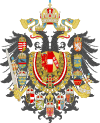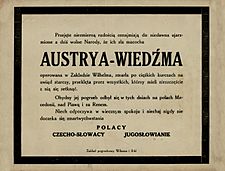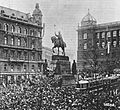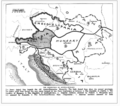Austria-Hungary facts for kids
Quick facts for kids
Austro-Hungarian Monarchy
|
|||||||||||||||||||||||||||
|---|---|---|---|---|---|---|---|---|---|---|---|---|---|---|---|---|---|---|---|---|---|---|---|---|---|---|---|
| 1867–1918 | |||||||||||||||||||||||||||
|
|
|||||||||||||||||||||||||||
|
Motto: Indivisibiliter ac inseparabiliter
("Indivisibly and inseparably") |
|||||||||||||||||||||||||||

Austria-Hungary on the eve of World War I
|
|||||||||||||||||||||||||||
| Capital | Vienna (Cisleithania) Budapest (Transleithania) |
||||||||||||||||||||||||||
| Official languages |
Other spoken languages: Bosnian, Czech, Romani (Carpathian), Italian, Istro-Romanian, Romanian, Rusyn, Ruthenian, Serbian, Slovak, Slovene, Yiddish |
||||||||||||||||||||||||||
| Religion | 76.6% Catholic (incl. 64–66% Latin & 10–12% Eastern) 8.9% Protestant (Lutheran, Reformed, Unitarian) 8.7% Orthodox 4.4% Jewish 1.3% Muslim (1910 census) |
||||||||||||||||||||||||||
| Demonym(s) | Austro-Hungarian | ||||||||||||||||||||||||||
| Government | Constitutional dual monarchy | ||||||||||||||||||||||||||
| Emperor-King | |||||||||||||||||||||||||||
|
• 1867–1916
|
Franz Joseph I | ||||||||||||||||||||||||||
|
• 1916–1918
|
Karl I & IV | ||||||||||||||||||||||||||
| Minister-President of Austria | |||||||||||||||||||||||||||
|
• 1867 (first)
|
F. F. von Beust | ||||||||||||||||||||||||||
|
• 1918 (last)
|
Heinrich Lammasch | ||||||||||||||||||||||||||
| Prime Minister of Hungary | |||||||||||||||||||||||||||
|
• 1867–1871 (first)
|
Gyula Andrássy | ||||||||||||||||||||||||||
|
• 1918 (last)
|
János Hadik | ||||||||||||||||||||||||||
| Legislature | 2 national legislatures | ||||||||||||||||||||||||||
|
• Imperial Council
|
Herrenhaus Abgeordnetenhaus |
||||||||||||||||||||||||||
|
• Diet of Hungary
|
House of Magnates House of Representatives |
||||||||||||||||||||||||||
| Historical era | New Imperialism • World War I | ||||||||||||||||||||||||||
| 30 March 1867 | |||||||||||||||||||||||||||
|
• Dual Alliance
|
7 October 1879 | ||||||||||||||||||||||||||
|
• Bosnian Crisis
|
6 October 1908 | ||||||||||||||||||||||||||
|
• July Crisis
|
28 June 1914 | ||||||||||||||||||||||||||
|
• Invasion of Serbia
|
28 July 1914 | ||||||||||||||||||||||||||
|
• Empire dissolved
|
31 October 1918 | ||||||||||||||||||||||||||
|
• Austrian Republic
|
12 November 1918 | ||||||||||||||||||||||||||
|
• Hungarian Republic
|
16 November 1918 | ||||||||||||||||||||||||||
| 10 September 1919 | |||||||||||||||||||||||||||
| 4 June 1920 | |||||||||||||||||||||||||||
| Area | |||||||||||||||||||||||||||
| 1905 | 621,537.58 km2 (239,977.00 sq mi) | ||||||||||||||||||||||||||
| Population | |||||||||||||||||||||||||||
|
• 1914
|
52,800,000 | ||||||||||||||||||||||||||
| Currency |
|
||||||||||||||||||||||||||
|
|||||||||||||||||||||||||||
Austria-Hungary was a large country in Central Europe that existed from 1867 to 1918. It was a special kind of monarchy called a "dual monarchy." This meant that Austria and Hungary were united under one ruler, the Emperor-King.
This empire replaced the earlier Austrian Empire. It began with a big agreement in 1867 between the powerful Habsburg family, who were the rulers, and the people of Hungary. Austria-Hungary was a "great power" in Europe. It was made up of many different groups of people. Even with some disagreements between these groups, the empire saw a lot of economic growth. New factories and industries grew, and there were many social changes.
The Habsburg family ruled as emperors over the western part of the country (Austria). They also ruled as kings over the Kingdom of Hungary. Hungary had its own government for many things. But it worked with Austria on important issues like foreign policy and military matters.
The main capital city of the empire was Vienna. Austria-Hungary was the second largest country in Europe by land area. Only the Russian Empire was bigger. It also had the third largest population, after Russia and the German Empire.
Contents
How Austria-Hungary Was Formed
The country of Austria-Hungary was created by an agreement in February 1867. This agreement is known as the Ausgleich. Before this, the Austrian Empire had become weaker. It had lost wars in 1859 and 1866.
Also, the Hungarian people had been unhappy with Austrian rule for a long time. They had even tried to gain independence in 1848–49.
Emperor Franz Joseph wanted to keep the empire together. He needed the support of the Hungarian nobles. The Hungarians wanted to be seen as equals to the Austrian leaders. So, they reached a compromise.
How the Government Worked
Austria and Hungary each had their own parliament and their own prime minister. The monarch (the Emperor-King) helped keep the two parts working together. In theory, the monarch had a lot of power. But in reality, their power was limited.
The central government, led by the monarch, was in charge of a few key things for the whole empire. These included the army, the navy, foreign policy, and a shared customs union (rules for trade).
Austria-Hungary and World War I
The next in line to the throne was Franz Ferdinand. He was the nephew of Emperor Franz Joseph. On June 28, 1914, Franz Ferdinand visited Sarajevo, the capital of Bosnia and Herzegovina. There, he was attacked and killed.
Some leaders in Austria-Hungary had wanted to take action against Serbia for a long time. They used this event as a reason to act. They decided to attack Serbia. They gave Serbia a list of ten demands. This was called the July Ultimatum. They expected Serbia to refuse.
Serbia accepted most of the demands, but not all of them. Because of this, Austria-Hungary declared war on Serbia.
These events quickly led to a larger conflict. Russia began to move its army to help Serbia. This started a chain reaction of armies moving across Europe. It was the beginning of World War I.
The End of the Empire
As World War I was ending, it became clear that the Allied powers would win. Different parts of the Austro-Hungarian Empire began to declare their independence. They formed their own new countries.
The following new countries were created from the lands that used to be part of Austria-Hungary:
Some lands that belonged to Austria-Hungary were also given to Romania and Italy.
Images for kids
-
Traditional costumes of Tyrol.
-
Military parade in Prague, Kingdom of Bohemia, 1900.
-
The Great Synagogue in Pécs, Hungary, built in 1869.
-
Dubrovnik, Kingdom of Dalmatia.
-
A picture often linked to the capture of Gavrilo Princip in Sarajevo, 1914.
-
Franz Josef I and Wilhelm II with military commanders during World War I.
-
Italian troops in Trento on 3 November 1918, after the Battle of Vittorio Veneto.
-
Map showing how the Treaty of Trianon changed Hungary's borders.
-
New borders of Austria–Hungary after the Treaty of Trianon and Saint Germain (1919–1920).
See also
 In Spanish: Imperio austrohúngaro para niños
In Spanish: Imperio austrohúngaro para niños



































